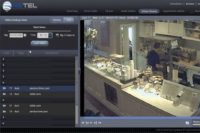It’s a balancing act.
James Connolly wanted to significantly cut losses while having better images for liability and prosecution use.
Tatiana Fokina, on the other hand, wanted to create a secure shopping experience that matches her inventory and customer profile.
Welcome to security video in retail environments, where the technology can go from shelves to aisles to shoplifters to fraud to merchandizing and analyzing customer traffic patterns.
“The decision to upgrade security video capabilities was one of several significant measures the company has employed to address shortage issues in stores,” says Connolly, senior vice president of asset protection for retailer Burlington Coat Factory.
The first Burlington Coat Factory store opened in 1972 and the retailer now operates 500 stores in 44 states and Puerto Rico. Loss prevention is a critical department at each of the stores, and the team works closely with front-end staff and managers to ensure that employees strive to stop theft before it starts.
Addressing Shrinkage
So Connolly sought to upgrade video surveillance capabilities to address shrinkage in stores and to provide a video platform for marketing, operations and safety. Company growth required expansion of remote viewing capabilities. Another aim: Install remote viewing stations at each store’s public entrance to present a professional image and reflect security and technology to shoppers.
There also is integration.
“In addition to the video surveillance upgrade, we have also upgraded our electronic article surveillance systems, implemented detection systems and specialty EAS tags, and expanded in-store burglar alarms,” says Connolly.
Retail enterprises have unique installation and design needs.
New systems need to be installed during nighttime hours so as not to interfere with daily store operations. Another challenge: “Burlington Coat Factory does not build stores from ground up,” Connolly observes. “We lease preexisting buildings and modify to accommodate our store’s concept. This creates issues because we are in buildings with every type of layout and configuration, from old department stores to warehouse stores, specialty stores and more.”
New York’s American Integrated Security Group (AISG) is the exclusive integrator at BCF locations. A pilot installation was conducted at two of the company’s stores in early 2012, and the retailer then decided to roll the solution out to additional stores.
Cameras and VMS
Technology includes 15 Vivotek 360 degree fisheye cameras and five to 10 Axis Communications fixed minidomes, depending on location. The 360-degree cameras cover large areas and allow use of fewer cameras. At each register area, low-profile domes are installed no higher than 10 feet from the floor, uniformly for visual appeal, to achieve best image quality. Each retail aisle has a 360-degree dome camera installed slightly higher to provide a broader view. One 360-degree camera can view an area that previously required eight cameras.
A wide dynamic range dome provides complete coverage at the entrance to each store. Select stores also have 360-degree cameras outside the main entrance or at the corner of the building to monitor the parking lot. In addition, cameras are installed at the back of the building to cover the dock or employee entrance.
The video management system (VMS) has built-in dewarping functionality to allow BCF to create dewarped images from the fisheye cameras. New images can be dewarped on the fly, and dewarped images function as separate camera feeds in the VMS and for evidentiary support.
A wireless interface enables remote viewing at stations located at store entrances, and at off-site locations remotely by regional and corporate loss prevention teams and select staff members. Store operations and design teams can also access cameras to assist their disciplines. Modularity makes it easy to relocate and expand the system.
The integrator worked with the IT department to obtain IP addresses and virtual private network or VPN logins for each store. AISG also has a VPN connection to the stores for remote management, support and maintenance. The system operates on separate servers and does not require direct IT support.
“The new surveillance equipment has helped BCF stores decrease their shrinkage, in some cases by more than 90 percent,” Connolly says. “In several instances, the video images enabled us to see the details of thefts and the perpetrators with 100 percent clarity, leaving no doubt of criminal intent.”
The Right Solution
Levy Acs, president and CTO, AISG, points out that “whether implemented to stop losses, drive revenue or both, choosing the right solution has a proven impact on retail profitability. Historically slow-to-adopt markets are now embracing IP because IP offers never before available capabilities such as fully integrated facial recognition, perimeter protection, demographics and thermo-graphic analysis. IP delivers the ability to integrate other systems to deliver users with a comprehensive view of their overall infrastructure.”
Acs also sees expansion of video beyond typical security needs.
“In operations, there is monitoring of customers in a waiting line, and there are numerous applications on the merchandising side,” adds Acs. And video integrated with point of sale or POS systems can aid in fighting fraud and as a forensics tool.
For Tatiana Fokina, CEO at Hedonism Wines, security cameras integrated with specialty EAS tags help project the image she wants her customers to see and feel.
In addition to design and placement of security video, Fokina worked with EAS source Checkpoint Systems to create an innovative solution to allow wine bottles, to be securely open-displayed on retail shelves without damaging the bottle’s appearance.
This security device does not conceal the top of the bottle, allowing customers to inspect the cork. Most innovatively, what Checkpoint calls Alpha Steel Grip Bottle Wrap contains a rubber insert that prevents accidental damage to the bottle’s foil, saving the shop in replacements. Some 50,000 customized wraps were manufactured, each bearing Hedonism’s logo and colors. Seven months after delivery, the shop has not seen a single theft.
As with other retail enterprises, such an integrated security approach “makes products more approachable for customers,” points out Fokina. “That is our essential aim – to create an experience that complements our mission.”
A Quality Experience
And it is an aim shared by Ryan and Sarah Lindemann, owners of a Woodhouse Day Spa franchise in Ft. Wayne, Ind. It deployed IQinVision megapixel cameras at their facility to enhance guests’ security and overall quality experience. Homeland Technology Group is the integrator for this project. What really sets the business apart is focus on customer service and in creating a quiet, restful place to escape.
About four years ago, the spa owners installed an analog video surveillance system. “The facility is quite large, and we wanted to keep track of where everyone was. Unfortunately, that system proved cumbersome: it was difficult to retrieve the video we wanted, and the image quality was bad,” Ryan Lindemann recounted.
The Lindemanns decided to upgrade to IP video surveillance. Now, the Woodhouse Day Spa has 34 megapixel cameras deployed in public areas, at the check-in and check-out counters, in the retail shop, laundry room and outside the front entrance of the 10,000-square foot facility. No cameras are installed in any treatment rooms, of course. Video from the cameras is managed by Exacq Mobile video management software.
Lindemann explains that the system is utilized 90 percent of the time for live monitoring and the balance for incident review. Staff can monitor video at the check-in and check-out desks, the employee break room has a monitor, and Sarah Lindemann, the spa manager, keeps tabs on activity from a 52-inch monitor in her office.
“It’s funny, when we first installed this advanced system, the employees thought it was to monitor them. But rather quickly they became aware how the system can be used to create an enhanced environment and customer experience. Video is another tool to help them do their job better,” adds Ryan Lindemann.
While the spa doesn’t experience any significant security incidents, the video system has been used to review video of when an item went missing, or if a guest questions whether a treatment went the prescribed amount of time. “We can go back and confirm when someone entered the treatment room and when they exited the room. We can show it to our guests, and it’s amazing how quickly they understand.”
Retail stores are, of course, at the end of a chain that includes warehouses and distribution centers.
That’s the case for Stephan Kazes, managing director, Malca-Amit warehouse, which serves diamond retailers.
Levering Existing Gear
Malca-Amit installed more than 65 Avigilon HD cameras ranging from two MP to 29 MP, along with several Avigilon analog video encoders to boost the performance of its existing analog-based surveillance cameras at its 10,000 square foot warehouse and its corporate office.
Security personnel continuously manage the system live around-the-clock to confidently ensure the safe transit of its clients’ assets, meet industry standards and maintain “known shipper” status to help grow its business. Additionally, security personnel can find event details and share video with key stakeholders in minutes.
“Because we store and ship a high volume of very valuable jewelry and diamonds, we need a surveillance system that offers superior image quality and advanced functionality to help us track and safeguard our customers’ precious commodities from origin to delivery,” says Kazes. The company is regulated by the UK Department of Transport and must undergo an annual inspection to maintain “known shipper” status to ship goods by airfreight. “We needed a way to gain a clear view into our daily operations to meet industry standards, protect our facility from theft and ensure the highest quality customer service possible.”
Then there is the attraction for retailers of hosted video.
“When you have video surveillance, security is a given,” says Chris Johnson, owner of two Jersey Mike’s sub sandwich locations in Irmo, South Carolina. “But hosted video gives me real-time visual feedback about store operations to improve our efficiency and service quality. I could run all the ticket system reporting in the world, but seeing is believing.”
Johnson worked with an integrator who proposed hosted video: five Axis network cameras with HDTV quality and two-way audio installed at each location streaming to a cloud platform. The system is augmented with a NAS device and an uninterrupted power supply to record 60 days of 720p video even if power or Internet is lost.
Johnson frequently uses his iPad and iPhone to monitor both stores via the cloud portal and look in on everything from sub-making efficiency, to customer flow, to whether employees are following health guidelines.
With the cameras configured for motion and audio detection, hosted video works a 24-hour shift. The video’s error checking system also regularly pings the cameras to ensure they are functioning. “I received an email alert at midnight with a video clip sent by A3,” says Johnson. “It was of a police officer doing his rounds. His flashlight triggered the motion detection. While he obviously wasn’t a threat, it gave me great peace of mind to know that everyone was doing their part: the local police, the cameras and our security partners.”
Security Solution Shopping Tips
- High-definition video has gone mainstream and is more cost effective since you can do more with less.
- Look for cameras to cover large areas and integrate with other systems including POS and EAS.
- Leverage your existing assets through video encoders while improving video quality.
- Concentrate on open architecture.
- Think business intelligence and reuse security video by analyzing demographics, people counting, shopper dwell times.
- Go outside the box. Integrating video with other retail systems opens up to myriad searches including by credit card number, for example.
- Look for multi-purpose and cross functionalities of the security video.
- Explore exception-based reporting, as well as analytics as a service through a third party specializing in retail.
- Don’t expect megapixel cameras to naturally reduce the number of cameras needed. Location is the key to placement.
These tips are provided by Bryan Schmode, executive vice president of global sales at Avigilon and Hedgie Bartol, retail business development manager, North America, with Axis Communications.
Mutual Services Under Attack
While many enterprises conduct routine background screenings of candidates prior to hiring, retailers and their loss prevention directors often have an additional tool: database services of workers and sales associates accused of stealing. The retailers feed data from their store locations into the services and then access them during a hiring process. The aim: information to keep employees from working again in retail elsewhere.
The recent problem is that the services, which are legal, are attracting handfuls of lawsuits and the attention of regulators since such databases allegedly contain scant details about suspected thefts and routinely do not involve criminal charges.
The Federal Trade Commission has fielded complaints about the databases and is examining whether they comply with the Fair Credit Reporting Act, a federal law aimed at curbing inaccurate consumer information while providing consumers more control, Anthony Rodriguez, a staff lawyer at the agency, was quoted in a front page New York Times article.
One database player is GIS (General Information Services, Inc.). That company sees growth of continuous monitoring beyond pre-hire through mutuals.
“As a background screening tool, ongoing criminal monitoring allows employers to stay current on their employees’ criminal background,” says Matt Robbins, vice president at GIS and resident retail industry expert. “This rapidly expanding trend allows employers to screen their employees on an ongoing basis, rather than only pre-hire or when the employee is being considered for a promotion. In doing so, retailers can be confident that the people representing them to the world remain free of barrier records.”








